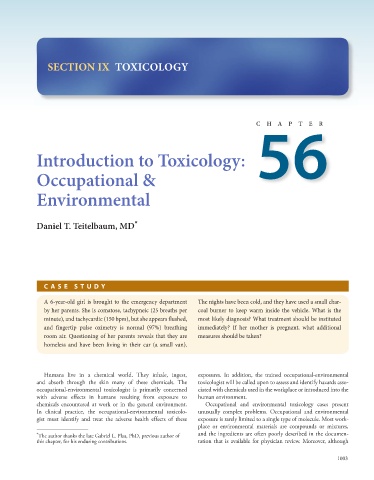Page 1017 - Basic _ Clinical Pharmacology ( PDFDrive )
P. 1017
SECTION IX TOXICOLOGY
C H A P T E R
Introduction to Toxicology: 56
Occupational &
Environmental
*
Daniel T. Teitelbaum, MD
C ASE STUD Y
A 6-year-old girl is brought to the emergency department The nights have been cold, and they have used a small char-
by her parents. She is comatose, tachypneic (25 breaths per coal burner to keep warm inside the vehicle. What is the
minute), and tachycardic (150 bpm), but she appears flushed, most likely diagnosis? What treatment should be instituted
and fingertip pulse oximetry is normal (97%) breathing immediately? If her mother is pregnant, what additional
room air. Questioning of her parents reveals that they are measures should be taken?
homeless and have been living in their car (a small van).
Humans live in a chemical world. They inhale, ingest, exposures. In addition, the trained occupational-environmental
and absorb through the skin many of these chemicals. The toxicologist will be called upon to assess and identify hazards asso-
occupational-environmental toxicologist is primarily concerned ciated with chemicals used in the workplace or introduced into the
with adverse effects in humans resulting from exposure to human environment.
chemicals encountered at work or in the general environment. Occupational and environmental toxicology cases present
In clinical practice, the occupational-environmental toxicolo- unusually complex problems. Occupational and environmental
gist must identify and treat the adverse health effects of these exposure is rarely limited to a single type of molecule. Most work-
place or environmental materials are compounds or mixtures,
* The author thanks the late Gabriel L. Plaa, PhD, previous author of and the ingredients are often poorly described in the documen-
this chapter, for his enduring contributions. tation that is available for physician review. Moreover, although
1003

